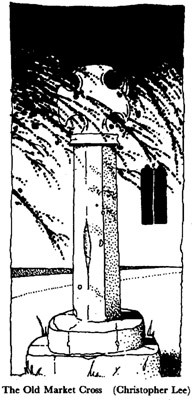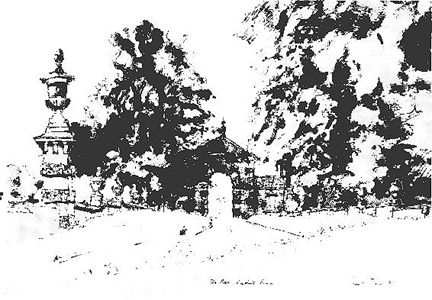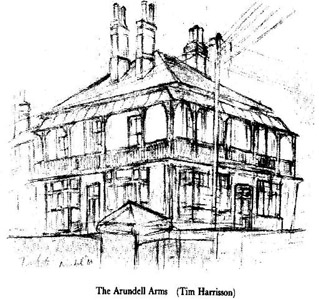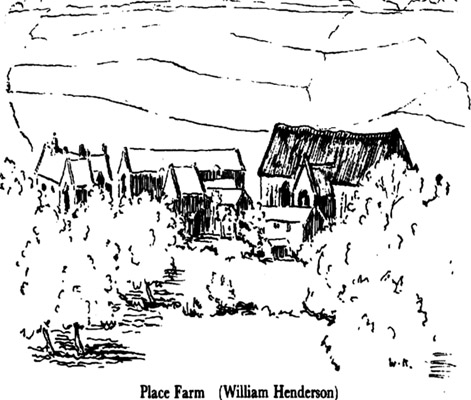

[Ed. note: The following text and images are taken from the brand-new, 1999 edition of A Tisbury History by Jill & Peter Drury, which is a history of the town of Tisbury, Wiltshire, England - the namesake of Tisbury, Massachusetts. Contact the Drury Family for more information about this newly revised book, published in December, 1999.]
This is a story of a village and how the lives of its inhabitants have been affected by the course of time. Although historical events have shaped the story, it is the spirit of the people that has given it life and colour. The actors in the pageant are real people, not always the comfortable characters that the chroniclers would have us believe, but painted, like Cromwell's portrait 'warts and all'.
Many of the stories near our own times are related in the villagers' own words, and they reflect both compassion and humour. It is those qualities which has given Tisbury the character and charm which is so evident today.
1. Geology and early history of Tisbury until 1066
2. After the Norman Conquest * Fonthill Bishop and Fontill Gifford * Anstey and the Knights Hospitallers * West Hatch to 1305.
3. More of West Hatch * Early Wardour until the arrival of the Arundells
4. Mediaeval Tisbury * Chicksgrove and the Davis family * Fonthill estate 1550 * 1660 * West Hatch and the Hyde family
5. The Arundells and Wardour * Early settlement in America and the founding of West Tisbury and Chilmark on Martha's Vineyard * Wardour until 1829
6. St John's Church * The Reformation * The Nonconformists * The Victorian * 'Age of Improvement'.
7. Eighteenth and Nineteenth centuries * Fonthill estate * Pythouse riots * Rural poverty and the advance of education
8. Mid-Victorian changes * Turn of the century
9. Tisbury in two World Wars
10. Tisbury today.
 Extracts from:
Extracts from: "Tisbury, often called the capital of the Nadder Valley, lies in the soft lap of the great chalk downs that sweep and fold in from the south and east to meet the lower slopes of Lady Down and Dumpling Down. It is the lower slopes, which have given so much character to the villages in the valley. The lovely textured stone they yield has provided the perfect material for builders and craftsmen, who for generations have worked in this area.
To the north of the village are the large Abbey Woods and the smaller Ridgewood, where the trees spill Out from Ridge Hill and the Terraces near Fonthill, while to the south west of Tisbury the dense woods of Wardour Park have sent out small armies of trees, whose clumps are disposed upon the downland slopes, marshalled as if for battle.
Many millions of years ago this whole area was covered by a tropical sea. As the Earth evolved the sea receded, leaving a chalk plateau, which met the ridges of a wide limestone belt stretching from Dorset to Yorkshire. Great changes then took place. The actions of rain and winds began to eat away the overlying chalk into the V-shaped finger that is so familiar today, and during those times there were several great upward foldings of the underlying limestone rocks, which de-veloped open cracks or joints. Further rains and frosts then dislodged the centre of the uplifted fold disintegrated, leaving instead a valley, with the former downward slopes as ridges. This reversal is known to geologists as Inverted Topography, and Wardour Vale is a classic example.
These disturbances of the earth's crust have exposed among other things a fascinating substance lying in the lower Chalky Ragstones in a band of Black Chert. This is a coral, Isastraea oblonga, known locally as `starred agates'. At the time it was first exposed, this area was visited by some of the first true human beings to walk in Europe, about a hundred thousand years ago. It was only the pathetic remains of a young woman's skull on an old river-bed in Kent which brought these facts to light. She had been buried with a piece of Tisbury coral; a coral unique to Tisbury. This small piece of `starred agate' had probably been picked up by the girl when she was a child, and had been cherished throughout her life.
In prehistoric times much of the land was either barren rock or impenetrable forest and marshland, and it could in no way have been an hospitable environment for man. Joined at the time to the continent of Europe, it was the home of mammoth, the woolly rhinoceros, wolves and bears, who would have been strong and fierce competitors for the smaller game and edible herbage. It is little wonder that such men who were about during those times kept constantly on the move in a restless search for some peaceful place in which to settle.
It was the New Stone Age, or Neolithic man that first began to settle and to cultivate the land, and at the same time to build the early stone circles, notably the one at Avebury. Despite long and exhaustive argument, no one has been able to prove beyond all doubt the reason for these strange monuments. There can be little doubt that some complicated mathematics were involved, and the circles, like the ancient pyramids, will continue to intrigue scientific thinkers until the end of time. The stones of the oldest Wiltshire circle at Ave-bury have not been hewn, but the later one at Stonehenge, said to have been built about 3,700 years ago, has stones that have been tooled. The real mystery is this: how the men of the late Stone Age, or perhaps the early Bronze Age, had acquired the knowledge of advanced and accurate calculations evident on the one hand, whilst they had not at the same time properly learned the use of metals, and were still using stone implements.
The mystery will not be solved by the study of Tisbury's stone circle, for its last three standing stones were taken away during the latter part of the i8th century to form part of the grotto at Old Wardour. Its precise date is uncertain, and so is its former site, though it is said to have stood in one of three fields, adjoining each other near the junction of the Chicksgrove and Chilmark roads. One of these fields, known for many years as Lost Stone Field, was incorporated with the two others into the present Cemetery Field.
Among the later tribes who made their way across from Western Europe
were the Celts, and it was these Celtic or Ancient Britons who are believed
to have constructed the Iron Age fort known in later Saxon times as Wilburge
and now called Castle Ditches.
The next invaders were the Romans and it was they who began quarrying at
Chilmark using the stone for the road, which led from the Mendips through
Old Sarum to Winchester. This highway was of prime importance for the transport
of silver and lead. During the time of Roman Britain, subtle changes were
beginning to take place. Apart from the many mixed marriages, the character
of the native people was being altered by the early Christians, who had
already converted many of the Romans to Christianity under Constantine after
he became emperor in A.D. 306."
"Early in the fifth century the Romans left Britain and the Angles,
Saxons and Jutish tribes who came to Britain in the fifth and sixth centuries
brought back the pagan religions. The Celtic Britons, now reinforced with
good Christian obstinacy, resisted, and it is a measure of their success
in this direction to record that it was not until nearly the end of the
sixth century that the Saxons won the day and began to establish their settlements.
Tisbury was occupied by the West Saxons, and it was they who first gave
the village its name, though the first written form of it does not appear
until A.D. 759, when it was spelt Tissebiri. It is generally agreed that
the name derives from Tysse's Burh, and that it was named in this way to
denote an area controlled by a Saxon leader of that name, or one who founded
the settlement. The naming of towns after people is not so apparent here
as it is in the U.S.A., where, in former pioneer territory, one can see
names like Harrisburg, for example."
"In the early days before the Danes came, Tisbury's monastery was most
likely a large single building set on rising ground. Its walls would have
been split tree trunks set vertically, and there would have been an enclosure
surrounded by a stout fence, so that humans and live-stock alike could be
protected. There is now no trace of Saxon Tisbury, which is hardly surprising.
Traces of wooden buildings are difficult to establish if ground has later
been built over or otherwise disturbed.
Nevertheless, Tisbury or `Tysse's Burh' was considered to be a strong settlement,
as the Saxon name burh implied a place of defensive strength. The village
itself may well have begun life as a fragmented one, with the houses scattered.
Then, as land was cleared and tilled the disposition changed to become that
of a `Highway Village', following the course of a natural track or `green
road', and this form seems in general to have been maintained.
Though the Saxons built in wood in the first instance, their later important
buildings were certainly of stone, though curiously the influence of the
carpenter's design is very much in evidence in some of their stonework.
After the Danes' departure from Wessex it is most likely that Tisbury would
have had a Saxon stone church, for it was after all an important burh, and
it contained monastic lands. This church may well have been built at about
the same time that Alfred founded the town of Shaftesbury, though the only
proof of the existence of a Saxon church is in much later documents of the
time of Henry I (ii OCHI `35). These state that the church was held by Algar
and Herdyng, who also held between 6o and 100 acres of land nearby. They
also go on to say that the church was the focal point for burials over a
wide area around.
There has long been speculation as to where this church once stood. If the
area called Paradise, now partly built over but once a large field, was
in essence the same portion of land as that owned by Algar and Herdyng,
it could be assumed that the church once stood on that ground, possibly
at a point much farther to the north east than the present Norman building.
It is true that human skeletons have been found in the gardens of houses
on the north side of Church Street. These houses are mostly early Tudor,
and there is what looks to be a Saxon stone coffin built into the wall of
one of them.
There is yet one more theory. One of the essentials of any settlement is
a good water supply. In Tisbury this was supplied by the River Nadder, which,
before the introduction of efficient drainage, was deeper and wider than
it is now. Cathedrals and large churches were built close to rivers, simply
because the waterway provided more efficient transport for building stone
than could the rough tracks forming the early roads. It is more than likely
that the stone for building Tisbury's Saxon church came along the Nadder
on small barges, and that the Saxon church stood precisely where the later
Norman church now stands, with its stones incorporated in the larger Norman
church. The indigenous material is of the same age; only the mason's work
would have been different, and the remains of the earlier church would be
very hard to detect if such Saxon work were encased by the Normans.
It would also be well at this point to consider the character of the Norman
rulers. They did not turn everything topsy-turvy on their arrival, as had
been commonly supposed. They neither destroyed all things English or became
themselves involved in English culture. Even by 1153 the new Norman kingdom
was still undeveloped and indeterminate. Many of the higher ranks had become
Anglicised, and the lesser barons insular. Against such a background it
is difficult to imagine that Tisbury's old church would have been taken
down completely, and a new Norman church built on a different site; there
would have been no valid reason to do so. To enlarge and incorporate the
structure would have been a different matter.
Where the church stood is one matter: how the church fared is another. Religion
played a crucial role in people's lives in those times. The powers of Church
and State were finely balanced. The king granted the lands to the monasteries,
who paid their taxes and often provided serving men as fighting troops.
Monasteries were not merely self-supporting communities. They provided physical
sustenance for the poor and needy as well as spiritual comfort for the people.
Saxon earls and thegns manned their estates on the doorsteps of the monasteries,
watching the doings of both the Church and the laity lest any trouble should
arise. The king kept a wary eye on all with the aid of a vast army of spies,
a necessity to all who rule alone. The Church kept its eyes on everyone."

"When Sir Matthew Aundell died in 1592, his son Thomas succeeded
to the title and within three years of the accession of James I he was created
a baron. Whether this barony was to be the cause of the first Lord Arundell's
change of plan is not clear, though it may have been. It had been his intention
to settle in the New World, and he had actually chartered a ship, together
with his mother's cousin, the Earl of Southampton, for a voyage of discovery.
He probably felt that his first duty lay with the management of his estates,
and it was his daughter Ann and son-in-law Cecil Calvert, 2nd Lord Baltimore,
who set sail in the end. On St Cecilia's Day, 1633, the Ark, a vessel
of 360 tons, together with a 40-ton pinnace called the Dove, sailed
from Cowes to take the colonists to a new life in a strange land."
"A landing was made on the area of country called Maryland, and it
is said that the name was chosen to honour Henrietta Maria, consort of Charles
I. Annapolis, now the US Naval Acadamy, was called after Ann, Lord Arundell's
daughter; she gave the family name to Arundell County in southern Maryland,
and Lord Baltimore gave his name to what later became the State capital
of Maryland.
This settlement became unique in American mainland in that it had complete
freedom from religious dogma; all that was required was a sound Christian
belief. It was, furthermore, the only English colony on the mainland to
have no history of Indian bloodshed. Families in Maryland today whose records
bear the names Cornwallis, Gerard, Wintour, Talbot, Wiseman and Weld will
know beyond doubt that their ancestors were amongst those first settlers
in the state.
In Hook Manor, Ann Arundell's house in the parish of Donhead St Andrew,
there are plaster ceiling mouldings of the two ships which sailed out on
that voyage; they are the only ones known to exist.
Another successful voyage was to take place a year later by Thomas Mayhew
who was born in Tisbury in 1596. The name, once spelt Mahu, appears, earlier
in this book in the period 1276. At the age of 21, a legacy from his father's
will enabled Thomas to go to Southampton to train as a mercer. He arrived
in Massachusetts in 1631, as an agent between John Winthrop, Governor of
the Bay, and Matthew Craddock, a well-known London merchant."
"Mayhew lived at first on the mainland, at Meaford and later at Watertown.
He built and managed a gristmill for Thomas Craddock, and sent his son Thomas
to primary and grammar schools, where he seems to have done very well. The
mill on the other hand was not doing so well, and Craddock ended the agency
agreement in 1637. It seems highly probably that Thomas Mayhew was not the
sort of man who enjoyed managing other's affairs. After he had decided to
run the mill on his own account he had certainly made enough money to buy
two islands, one of which was Matha's Vinyard, off the shore of Massachusetts.
When young Thomas Mayhew was twenty-one, he moved into Martha's Vinyard
together with a number of people from Watertown, and established a community
at a place which is now called Egartown. Almost from the outset a church
society was set up and young Thomas was appointed pastor. He felt great
sympathy for the Indian inhabitants of the area, and was resolved to improve
their lot. One of his first steps was to master their language, and being
a born linguist he soon became an acknowledged authority on the Indian language".

Two travellers from America who came to Tisbury in 1977 were looking for
more tangible evidence of the past. They were Mrs Shirley Mayhew and her
daughter, descendants of Thomas Mayhew, who left Tisbury in 1631, and who
eventually founded the mission in Martha's Vineyard, off the Massachusetts
coast. Mrs Mayhew had come to search through the parish records for details
of her family. Not only did the visitors find what they were looking for,
they also made friends with many people in Tisbury and Chilmark, particularly
with Kay and Andy Pickering, who kindly put them up when they found at the
time that there was no hotel accommodation in Tisbury. This act of hospitality
led to exchange visits, which again forged the link between Chilmark and
Tisbury, England, and their counterparts in the U.S.A. When she left, Mrs
Mayhew took with her a piece of Tisbury coral, just as the young visitor
had over a hundred thousand years ago. Shirley Mayhew and her daughter were
also able to see the thousand-year-old yew tree in St John's churchyard,
whose sturdy offspring is growing in the Haven's Grace churchyard in West
Tisbury, on the island of Martha's Vineyard.
It is these strangers who, having found their way to this very secret part of England, see what we who live here take for granted. They see with fresh eyes the gentle sweep of the downs that have remained unaltered since man first walked and settled here. They see also the wooded terraces and lakes of Fonthill, and the sleepy Nadder as it twists and winds lazily, as though unwilling to leave the comfort of its valley."
